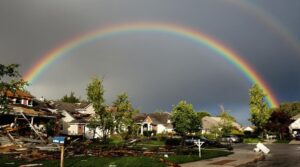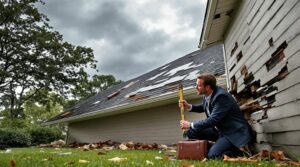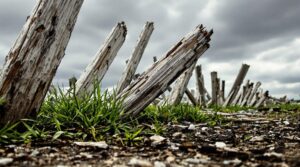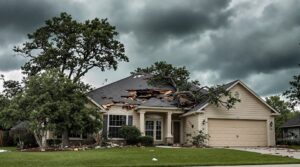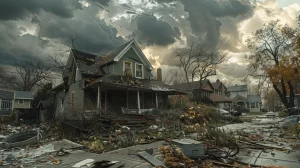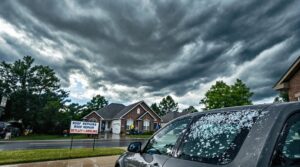Homeowners insurance typically covers wind damage to trees only when they fall and damage insured structures like homes or garages. Coverage includes both structural repairs and tree removal costs, usually capped between $500 and $1,000, after the deductible is met. Trees that fall without causing property damage generally aren't covered, and those falling due to rot or decay are excluded. Understanding specific policy limitations and coverage options helps guarantee adequate protection against tree-related damages.
Key Takeaways
- Insurance covers wind-damaged trees only when they fall and strike insured structures like homes or garages.
- Tree removal costs are typically capped between $500 and $1,000 when structural damage occurs.
- Trees that fall without damaging insured structures are generally not covered by homeowners insurance.
- Claims require proof that damage resulted from natural causes, not from tree rot or poor maintenance.
- Homeowners can file claims for neighbor's fallen trees that damage their property, regardless of tree ownership.
Understanding Wind Damage Coverage for Trees
The complexity of wind damage coverage for trees under homeowners insurance requires careful understanding of policy terms and conditions.
When trees fall due to wind damage and strike insured structures, homeowners insurance typically provides coverage under the dwelling coverage portion of the policy. However, specific limitations apply to removal costs, with most standard policies capping reimbursement between $500 and $1,000.
For insurance claims involving fallen trees to be valid, homeowners must demonstrate that the damage resulted from uncontrollable natural causes rather than negligence.
Trees that are merely uprooted by wind but do not impact insured structures generally fall outside the scope of coverage. Regular maintenance plays an essential role in determining coverage eligibility, as insurance providers examine whether proper tree care was maintained prior to the incident.
Property owners should conduct periodic assessments of their trees' health and structural integrity to minimize risk and guarantee coverage remains valid when wind damage occurs.
Consider adding umbrella coverage to your policy for additional protection against liability issues related to tree damage to neighboring properties.
Types of Tree Damage Covered by Home Insurance
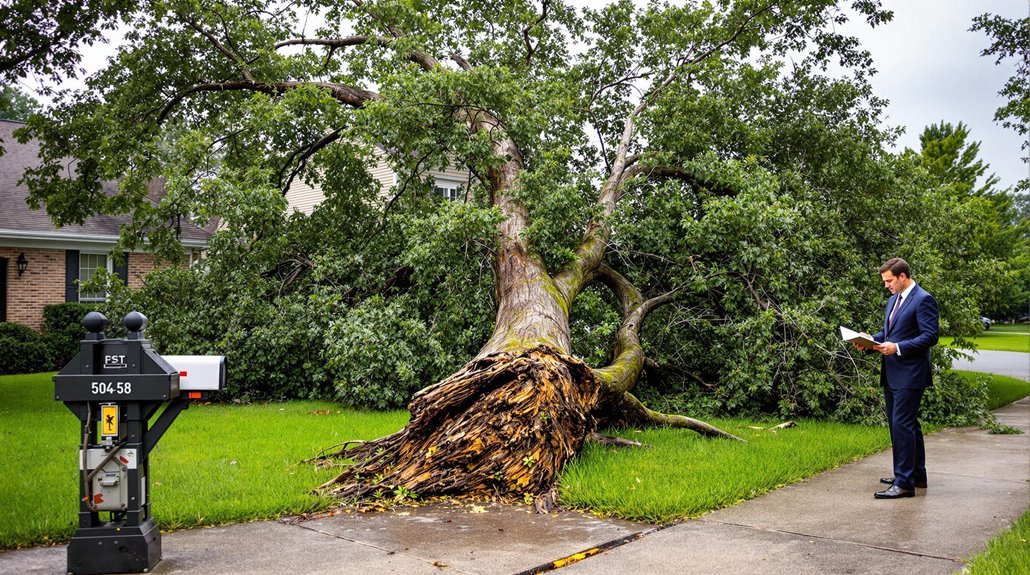
When severe weather strikes, homeowners insurance provides specific coverage for various types of tree-related damage, primarily focusing on incidents where trees impact insured structures.
The primary coverage applies when wind damage causes a tree to fall onto covered structures like homes or garages. In these situations, homeowners policies typically cover both the structural damage and tree removal costs, though removal expenses are often capped between $500 and $1,000 per tree. Before any insurance payout occurs, homeowners must meet their deductible.
A significant aspect of tree damage coverage is that the origin of the fallen tree usually doesn't matter. Whether the tree falls from the insured property or a neighbor's yard, the homeowners policy generally provides coverage as long as wind caused the damage.
However, it is essential to recognize that trees falling due to rot or decay are typically excluded from coverage, as these incidents aren't considered sudden or accidental events.
Understanding your policy limitations is crucial for ensuring you have adequate coverage for potential tree damage scenarios.
Filing a Claim for Wind-Damaged Trees
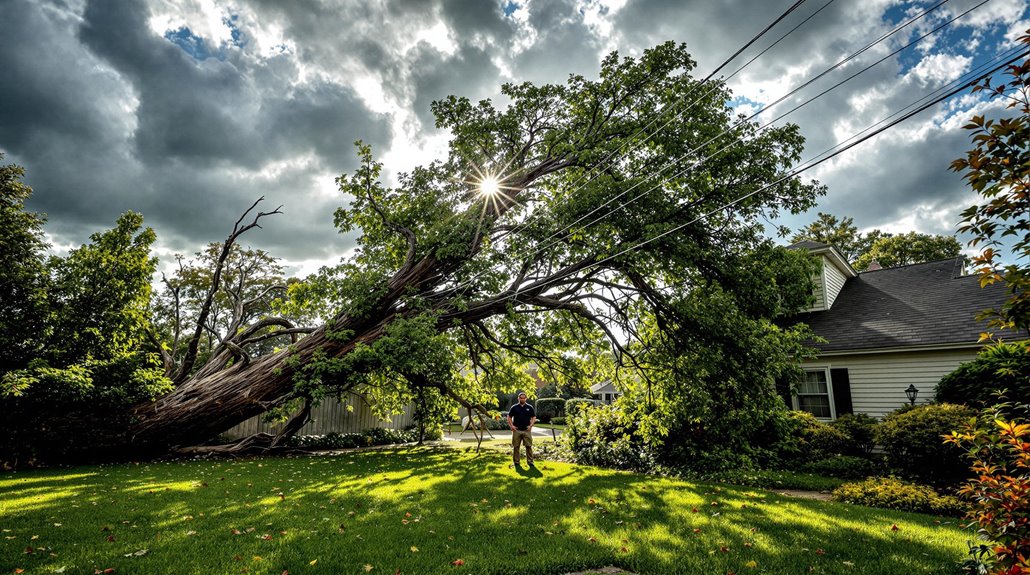
Understanding how insurance covers tree damage sets the foundation for proper claim filing procedures. When wind damage causes trees to fall on insured structures, homeowners should immediately initiate the claims process by documenting the damage with clear photographs. This documentation strengthens the claim and helps establish the extent of damage to both the tree and affected structures.
Homeowners should be aware that their policy deductible, typically ranging from $500 to $1,000, will affect their final compensation. Insurance coverage generally provides between $500 to $1,000 for removal costs when fallen trees damage insured structures. Coverage may also extend to cleanup costs if trees obstruct access to the property.
However, if wind-damaged trees fall without impacting structures, removal costs usually aren't covered by homeowners insurance.
Before filing a claim, property owners should review their policy details and guarantee they have thorough documentation of all damage to support their case.
Similar to roof damage claims, homeowners should maintain detailed maintenance records to demonstrate proper tree care and prevent claim denials.
Cost Limits and Deductibles for Tree Coverage
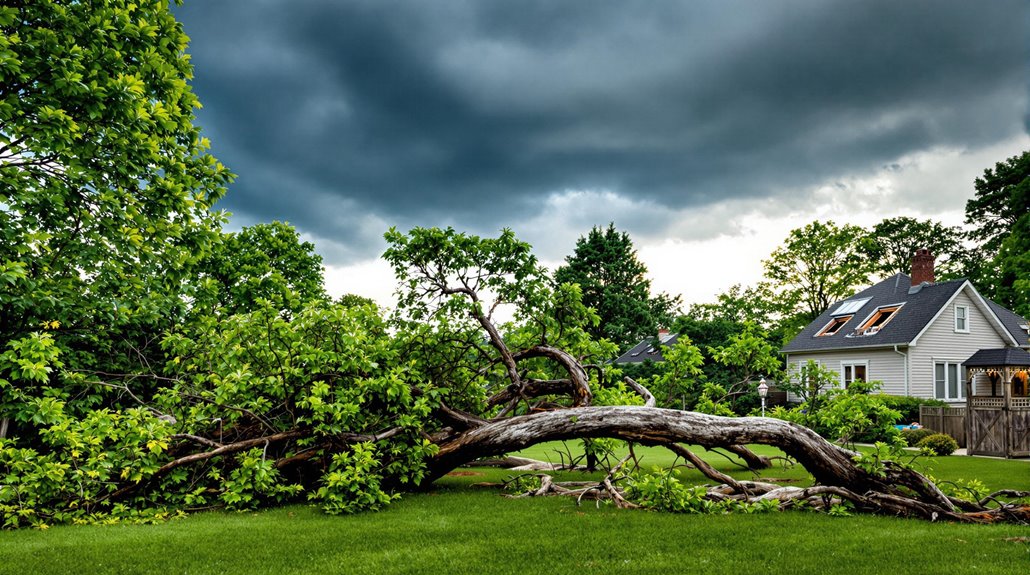
Although homeowners insurance provides protection against wind-damaged trees, strict cost limits and deductibles govern the actual compensation available to property owners. Most policies cap tree removal expenses between $500 and $1,000, and coverage typically applies only when trees fall on insured structures.
Before insurance compensation begins, homeowners must satisfy their policy deductible, which commonly ranges from $500 to $1,000. This means that if the tree removal costs fall within the deductible amount, the homeowner bears the entire expense.
Additionally, insurance coverage excludes preventive measures for leaning trees or those that threaten property without causing actual damage. When wind damage affects trees but they don't strike a covered structure, removal expenses often fall entirely to the property owner.
Given these limitations, homeowners should carefully review their policy details to understand specific coverage limits and deductibles, as individual policies may vary in their provisions for tree-related claims.
Understanding your insurance premium factors can help you negotiate better coverage terms for tree-related damages.
When Insurance Won't Cover Wind Damage to Trees
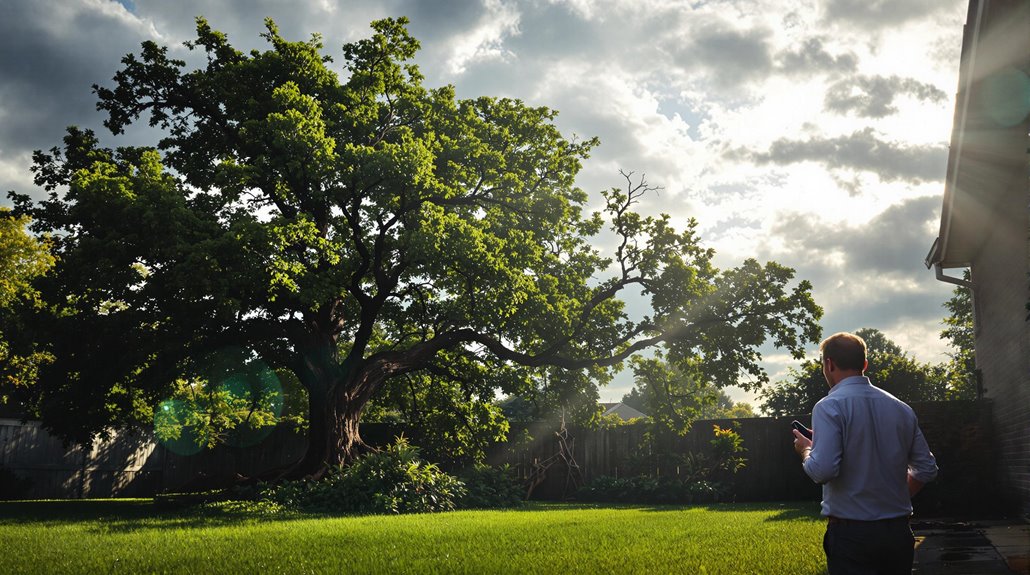
Many homeowners discover significant gaps in their insurance coverage when wind damages their trees. Homeowners insurance policies typically exclude coverage for wind damage to trees that do not impact a covered structure on the property. This can lead to unexpected expenses, as homeowners may be left to pay for tree removal and any other necessary repairs out of pocket. It’s essential for homeowners to review their policies carefully, as understanding the limitations of homeowners insurance wind damage coverage can help them make informed decisions about additional protection. Seeking specialized insurance riders or policies could provide the necessary coverage for such situations, ensuring peace of mind during stormy weather.
Even when a healthy tree falls due to strong winds, insured homeowners must bear the cost of removal if the tree doesn't damage their home or other insured structures.
Insurance companies may try to deny claims when trees show pre-existing conditions such as decay or poor health before the wind event. If a tree falls on a neighbor's property due to wind, the responsibility for damages typically falls under the neighbor's insurance policy, unless negligence by the tree's owner can be proven.
To protect against potential claims denials, homeowners should maintain detailed documentation of their trees' health through regular inspections and proper maintenance. This evidence becomes essential when disputing coverage decisions related to wind damage or establishing the tree's condition prior to the incident.
Neighbor's Trees and Insurance Responsibilities
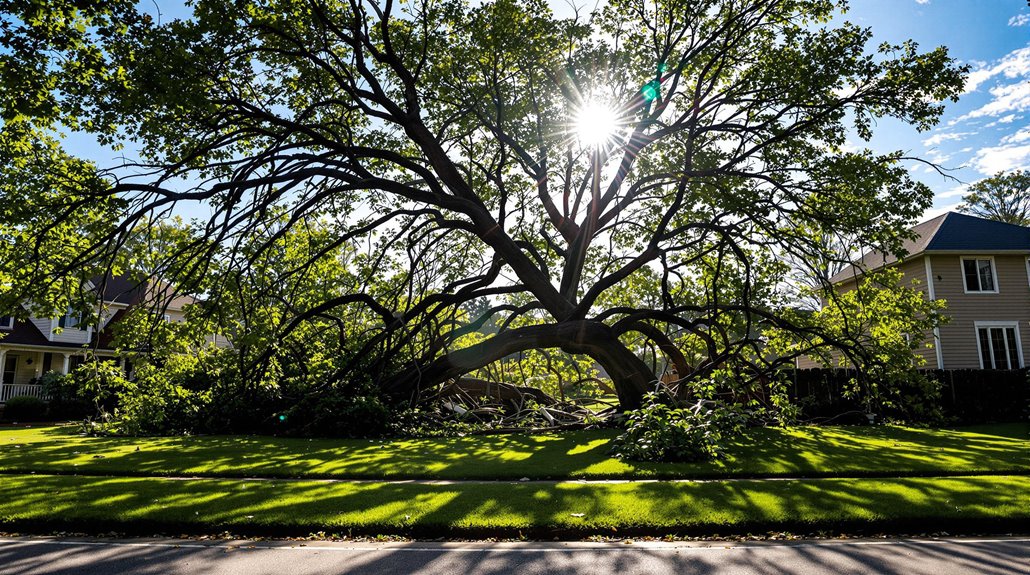
When a neighbor's tree falls onto adjacent property, determining insurance responsibility requires careful consideration of multiple factors. The homeowners policy covers damage to your home if the incident results from a covered peril, such as windstorms.
However, specific circumstances dictate who bears financial responsibility for damages and removal.
Key considerations for insurance responsibilities include:
- If the fallen tree causes damage, the affected homeowner can file claims for damages through their insurance, regardless of tree ownership.
- When no damage occurs, the property owner where the tree fell must handle removal of a fallen tree without mandatory cost-sharing.
- Cases involving neighbor's negligence require documented evidence of poor maintenance of property or failure to address known hazards.
Understanding these distinctions is essential, as the mere fact of ownership doesn't automatically determine liability.
Insurance companies evaluate each situation based on the specific circumstances, covered perils, and evidence of proper tree maintenance.
Effective communication between all parties involved, including insurance providers and property owners, enhances the likelihood of a successful claim resolution.
Tree Removal and Debris Cleanup Coverage
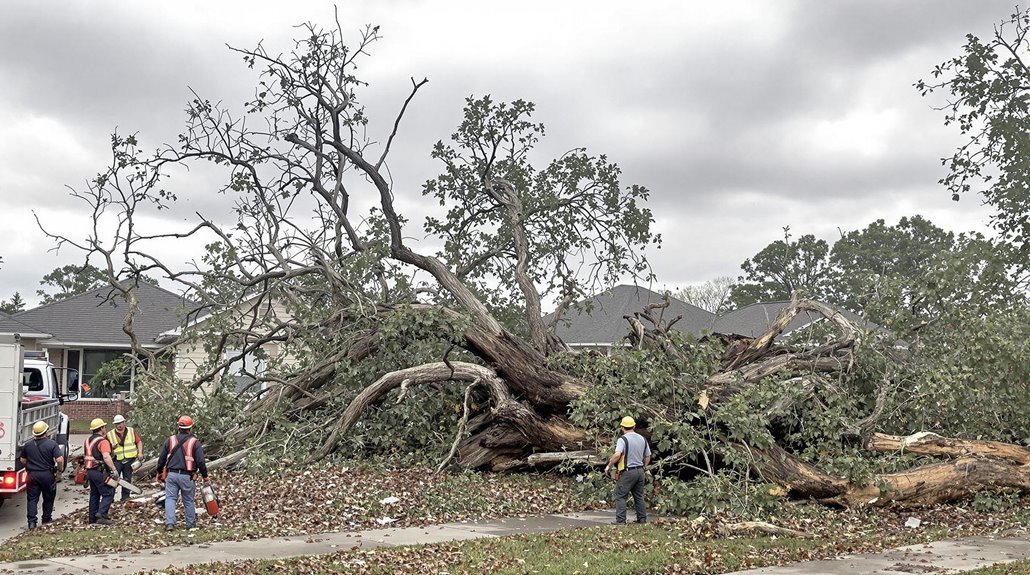
Homeowners insurance provides coverage for tree removal when wind damage causes trees to fall on insured structures, typically offering between $500 and $1,000 per fallen tree.
The insurance will only pay for removal and debris cleanup if the tree damages covered property or blocks essential access points like driveways or handicap ramps.
Property owners must document wind-related tree damage with photos and relevant evidence to support their insurance claims for removal costs.
Working with licensed public adjusters can help maximize settlement amounts for complex tree damage claims through detailed documentation and expert claim negotiations.
Coverage Limits For Removal
While insurance providers typically cover tree removal costs following wind damage, specific coverage limits and conditions apply to these claims. Homeowners insurance generally provides coverage for tree removal only when an insured structure sustains damage, with standard limits ranging from $500 to $1,000 per incident.
Key coverage limitations include:
- Total payouts for tree removal due to wind damage are often capped at 5% of the dwelling coverage amount.
- Debris removal is only covered if the tree damages a structure or blocks essential access points.
- Insurance does not cover preventive tree removal or situations without structural damage.
Given these specific limitations, homeowners should consult their insurance agent to understand their policy's exact terms and coverage limits for tree-related claims. Similar to property insurance basics, coverage typically requires meeting a deductible before any benefits are paid out.
Wind-Damaged Tree Cleanup
Following significant wind damage to trees, insurance companies typically process claims for both removal and cleanup services based on specific policy provisions and documented structural impact.
Coverage limits generally range from $500 to $1,000 for tree removal when wind-damaged trees fall on insured structures.
For homeowners insurance to cover debris cleanup, the fallen tree must have impacted a covered structure or dwelling. Property owners should document damage thoroughly with photographs to support their claims process.
If the tree falls without damaging insured property, removal and cleanup costs typically become the homeowner's responsibility.
Regular maintenance of trees plays an essential role in claim approval, as insurers may deny coverage if they determine negligent tree care contributed to the incident.
This underscores the importance of proactive tree management to guarantee coverage validity.
Working with public insurance adjusters can help homeowners navigate complex claims and identify potential underpaid settlements for tree-related damages.
When Insurance Pays Out
Insurance companies typically provide coverage for tree removal and debris cleanup when severe wind causes trees to fall onto covered structures, with standard policies offering reimbursement between $500 and $1,000 per incident.
To receive compensation for damage caused by fallen trees, homeowners must demonstrate that wind damage was the direct cause and that the peril is covered under their policy.
Key conditions for insurance coverage:
- The fallen tree must impact a covered structure or obstruct access points like driveways.
- Wind must be verified as the cause of the tree's collapse.
- Proper documentation, including photographs, must be submitted with the claim.
It's important to note that removal costs for trees damaged by wind but not affecting structures are generally not covered by homeowners insurance policies.
Reviewing your standard policy exclusions carefully will help you understand exactly what tree-related damages are covered under your homeowners insurance.
Preventing Wind Damage to Trees
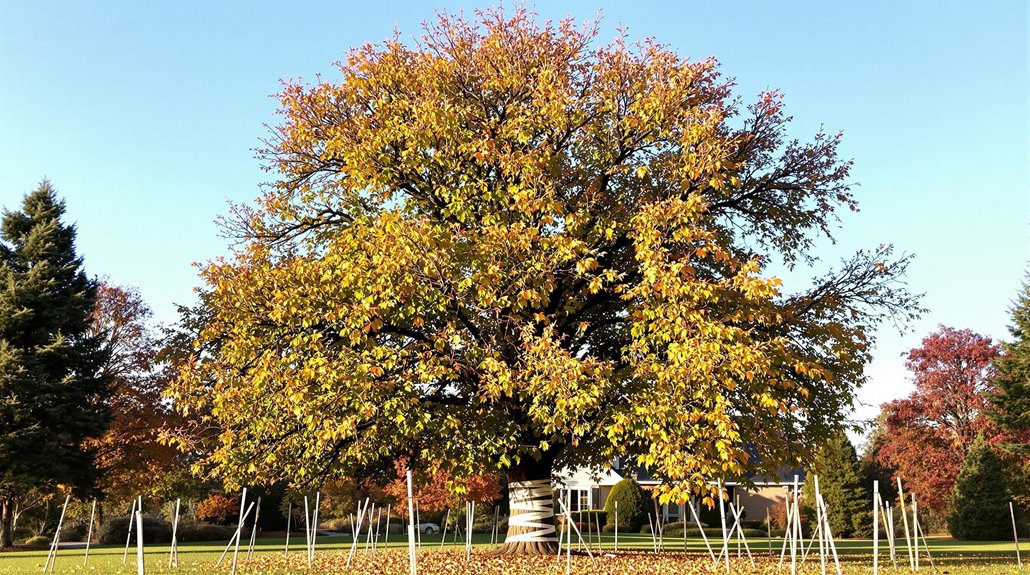
Although severe weather events cannot be controlled, homeowners can take proactive steps to minimize potential wind damage to their trees.
Regular inspections allow property owners to identify signs of weakness, such as excessive leaning or exposed roots, before storms strike. Implementing proper pruning techniques enhances structural integrity and can greatly reduce likelihood of damage during high winds.
Strategic planning plays an essential role in preventing tree-related issues. When planting new trees, consideration should be given to their placement relative to structures and their suitability to the local climate.
Species that are well-adapted to regional conditions typically demonstrate better resilience to wind stress. For young trees, appropriate staking methods support proper growth habits and wind resistance.
These preventive measures can help protect both trees and property, potentially reducing the need to remove a fallen tree or address property damage caused by storm-related incidents.
Alternative Insurance Options for Tree Protection
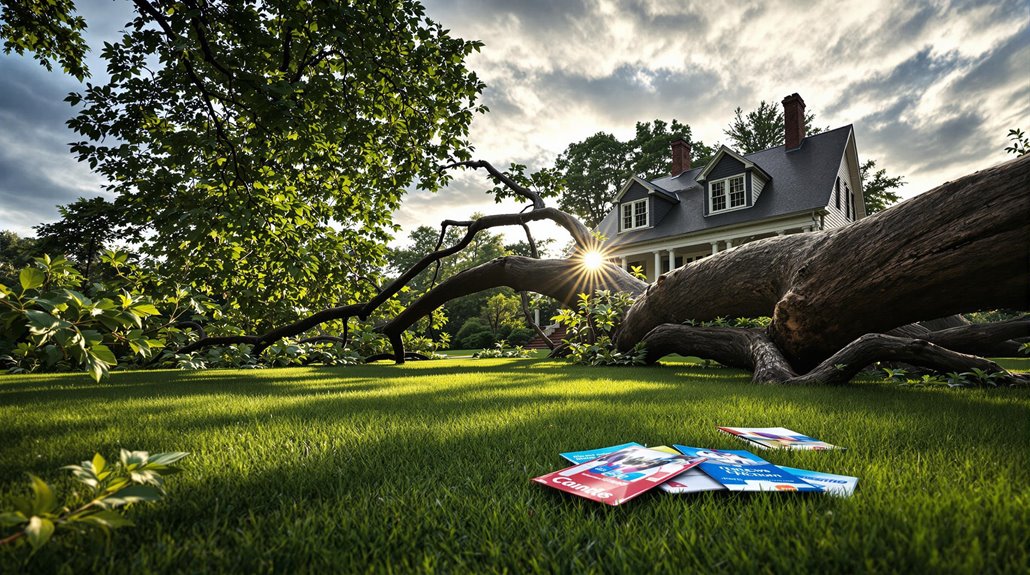
Several insurance options exist beyond standard homeowners coverage for protecting valuable trees and landscaping investments. For property owners seeking extensive tree protection, specialized tree insurance and additional coverage endorsements can provide enhanced security against various environmental risks.
These alternative insurance options often address gaps in traditional homeowners policies by offering specific protection for trees, shrubs, and other outdoor property.
Understanding your personal liability coverage limits is essential when evaluating additional insurance options for protecting trees that could potentially damage neighboring properties.
Key insurance solutions available include:
- Specialized tree insurance policies that cover specific tree types and associated care costs
- Additional coverage endorsements or riders focused on landscaping protection
- Tree replacement insurance that specifically covers replanting costs after covered perils
Outdoor property coverage through select insurers may provide higher coverage limits for landscaping elements compared to standard policies.
To determine the most suitable protection plan, homeowners should consult with a local insurance agent who can evaluate their specific needs and recommend tailored coverage options for their property's unique characteristics.
Frequently Asked Questions
Does Wind Insurance Cover Trees?
Homeowners insurance typically covers tree removal and property damage when wind storms cause trees to fall on insured structures. Policy details vary, with coverage limits for storm assessment and natural disasters usually capped accordingly.
How Much Does Insurance Pay for Tree Damage?
Insurance claims for tree damage typically cover up to 5% of dwelling coverage, with $500-$1,000 limits per tree removal. Coverage applies when storm damage affects structures, subject to policy deductibles and maintenance exclusions.
Who Is Responsible for Tree Removal After a Storm?
Property owners bear primary tree removal responsibilities after storms, regardless of tree origin. Insurance may cover costs if structures are damaged, while municipal services handle trees affecting public spaces.
Do Most Homeowners Insurance Policies Cover Wind Damage?
In an ocean of insurance complexities, most homeowners policies provide extensive coverage for wind damage, including protection against storm damage, though coverage limits and policy exclusions may apply to specific claims.
Final Thoughts
Understanding homeowners insurance coverage for wind-damaged trees requires careful policy review and proactive maintenance. With varying coverage limits, exclusions, and requirements, property owners must weigh their options carefully. Have you considered the potential costs of tree damage during severe weather events? By maintaining thorough coverage, documenting tree conditions, and implementing preventive measures, homeowners can better protect their property and financial interests against wind-related tree damage.
For homeowners dealing with tree damage or any other property damage claims under their homeowners insurance policy, insurance industry professionals and legal experts strongly advise consulting a qualified state-licensed public adjuster. Public adjusters work exclusively for policyholders, not insurance companies, serving as dedicated advocates throughout the claims process. These state-licensed professionals help navigate complex insurance policies, identify hidden damages often unknown to policyholders, thoroughly document losses, and negotiate with insurance companies to secure fair settlements while protecting policyholder rights.
The decision to hire a public adjuster can significantly impact claim outcomes by maximizing payouts, expediting the claims process, and reducing the stress of dealing with insurance companies. This allows homeowners to focus on recovery while ensuring their interests are professionally represented. Policyholders interested in discussing their property damage claims can request a no-obligation free consultation with a Public Claims Adjusters Network (PCAN) member public adjuster through our contact page.


